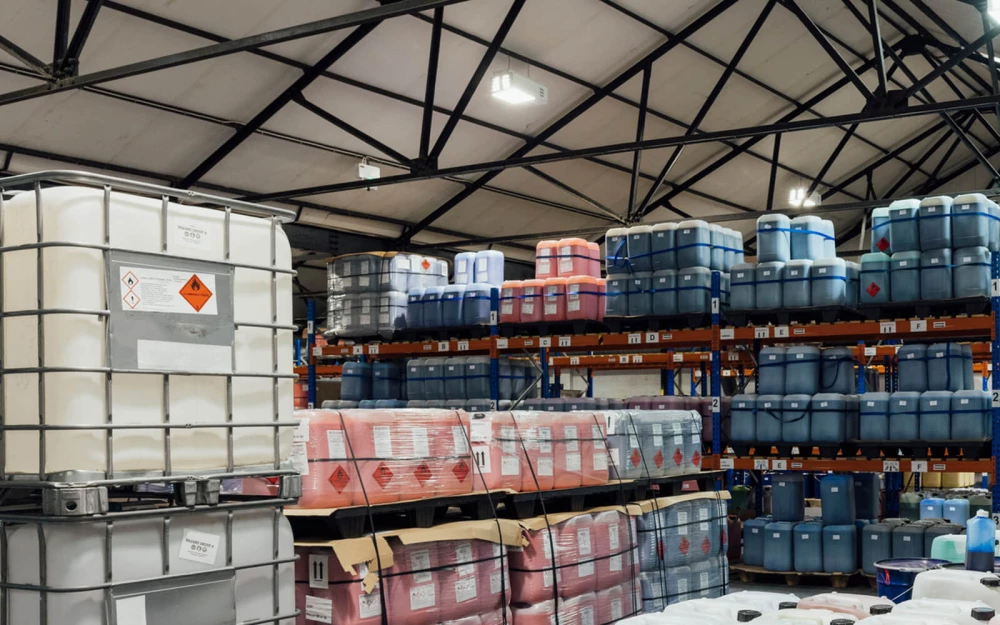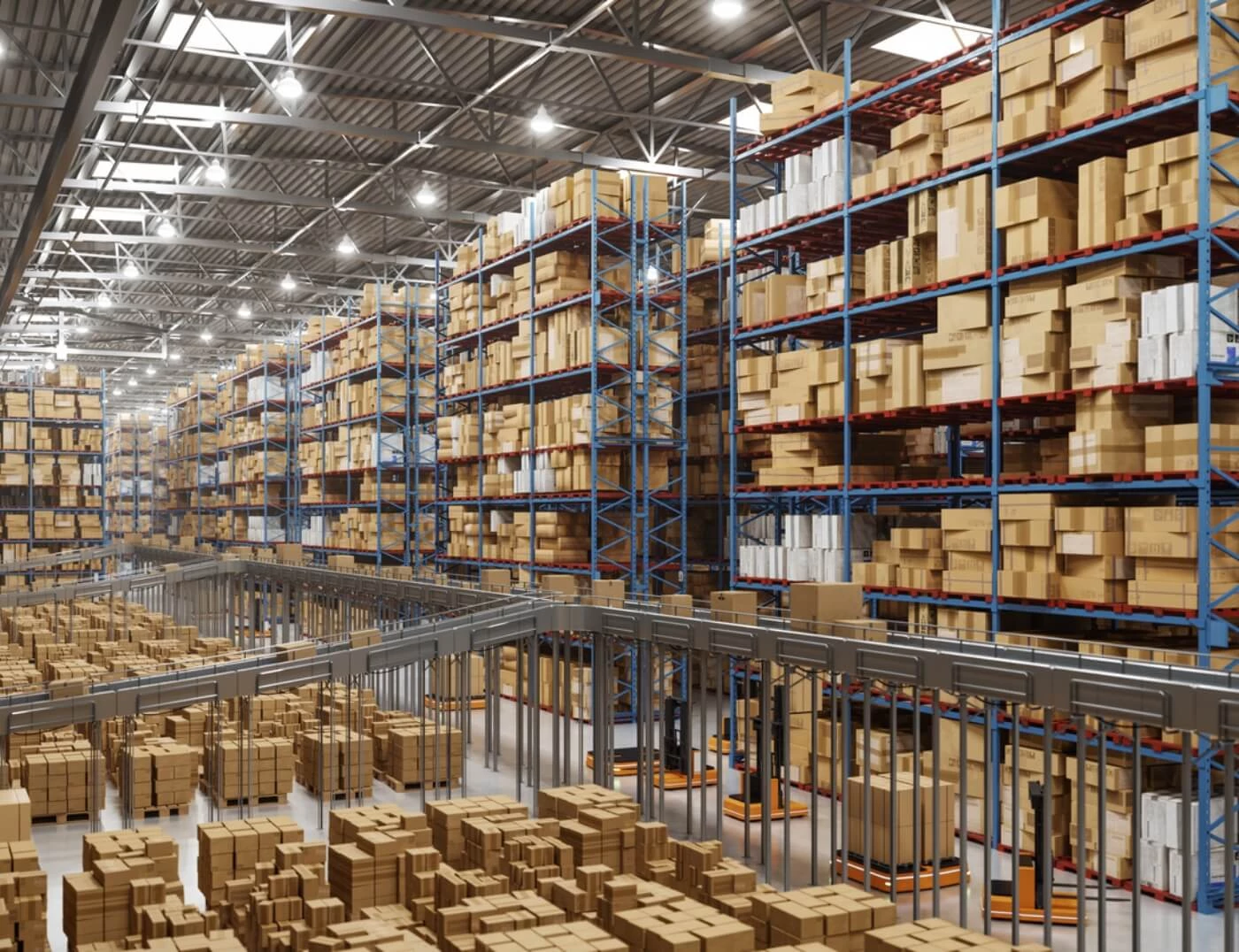
How to Safely Ship Hazmat Products
- Feb 7, 2025
- Distribution
- Retail Fulfillment

Hazardous materials (hazmat) are essential for many industries, including healthcare, manufacturing, and agriculture, where they are used for fuel, medical treatments, industrial processes, and more. While these materials are important for a variety of reasons, there are risks associated with them. When strict hazmat warehouse requirements and shipping regulations to ensure safety and compliance are not followed, hazmat materials can cause accidents and legal liabilities. However, when hazardous materials are handled and shipped according to safety regulations, the chance of harm is greatly reduced.
Partnering with a hazmat third party logistics (3PL) provider that is certified in hazmat warehousing to store, handle, and ship hazmat products can simplify the process, reduce shipping costs, and help businesses avoid expensive and dangerous mistakes. Unfortunately, not all fulfillment companies follow hazmat shipping laws. Working with a 3PL that offers hazmat logistics but bypasses hazmat regulations is not only unsafe but can also lead to serious legal repercussions, including fines and other sanctions. That is why it is so important to work with a compliant, trusted hazmat fulfillment partner who can protect your business, the environment, and your customers.
Hazmat shipping refers to the transportation of hazardous materials that could cause serious harm to people, property, or the environment if not handled properly. Hazmat shipping is heavily regulated by agencies like the U.S. Department of Transportation (DOT), International Air Transport Association (IATA), and International Maritime Dangerous Goods (IMDG) Code.
Hazardous materials are classified into different categories based on the type of risk they pose during transportation and handling. These materials include flammable liquids, toxic chemicals, explosives, radioactive substances, and more. Each classification has specific regulations for packaging, labeling, and shipping to ensure safety and compliance with local and international laws.
The Federal Hazmat Law enforces strict penalties for non-compliance through administrative actions, civil penalties, compliance orders, criminal penalties, and civil court actions. The Secretary of Transportation is empowered to investigate, issue subpoenas, and enforce compliance with hazmat regulations. The U.S. Attorney General also reserves the right to file civil actions in federal court, which can lead to injunctions, punitive damages, and additional civil penalties.
Civil penalties range from a minimum fine of $250 (or $450 for training violations) to a maximum of $50,000 per violation per day, increasing to $100,000 if the violation causes serious harm or property destruction. Compliance orders may also be issued to enforce corrective actions.
Criminal charges may be filed in cases of willful or reckless violations, with individuals facing up to $250,000 in fines and five years in prison and corporations facing fines of up to $500,000. If a violation leads to death or injury, penalties increase to up to 10 years of imprisonment.
1. Packaging Requirements
Hazardous materials must be packed in certified containers that are designed to prevent leaks, spills, or dangerous chemical reactions during transit. The type of packaging required depends on the classification of the hazardous material but common examples are UN-rated drums, boxes, jerrycans, cylinders, and intermediate bulk containers (IBCs). Some types of shipments also require inner packaging, absorbent materials, or other types of secondary containment to reduce the risk of dangerous leaks. Packages meant for hazardous materials must also pass performance tests such as drop tests, pressure tests, and stacking tests to ensure they will be reliable during real-world shipping conditions.
2. Labeling & Documentation
Proper labeling and documentation are critical for hazmat shipments to ensure packages are handled safely and comply with Hazmat safety regulations. Each package must display hazard class labels, handling labels, and placards that specify the type of danger the material inside presents (such as flammable, toxic, or corrosive) so potential hazards can be easily identified quickly. Labels are required to be clearly visible and resistant to damage from weather or handling.
In addition to labeling, documentation including the Material Safety Data Sheet (MSDS) must be included with the shipment in order to provide information on the chemical composition and appropriate emergency response measures. A shipping declaration that shares the hazard classification, proper shipping name, UN identification number, and emergency contact information is also required.
3. Training Requirements
Anyone involved in the packaging, handling, transportation, or documentation of hazardous materials must complete hazmat training to comply with legal and safety standards. Training requirements are specific to the type of hazmat being handled and whether the materials will be traveling by air, land, or sea.
Under Title 49 of the CFR Part 172, all hazmat employees must be trained in general awareness, function-specific procedures, safety measures, and security awareness. Workers who handle air shipments must also comply with IATA Dangerous Goods Regulations (DGR), which have additional training and certification requirements. Employees are required to refresh their training periodically, depending on the regulations, to ensure employees stay up to date with changing compliance rules and best practices for safe hazmat handling.
4. Carrier Restrictions
Not all carriers accept hazardous materials, and those that do typically have specific restrictions and requirements to ensure safe transportation. For example, USPS shares its hazmat shipping safety guidelines here.
Carriers may also limit the types of hazardous materials that they will ship, require additional packaging or labeling, charge higher shipping fees, or limit international shipments due to customs regulations. Additionally, the amount of hazmat that can be stored inside a building is limited by special storage requirements and some shipping routes may be restricted because of safety concerns, making alternative routes or special permits necessary.
G10 Fulfillment has put in the work to earn hazmat certification in order to provide expert solutions for hazmat fulfillment to our clients.
1) Every employee that handles dangerous goods in our warehouses goes through a course that helps them become an expert on hazmat storage requirements and how to package and ship dangerous goods.
2) We work with local fire marshals to ensure we are handling flammable hazmat safely.
3) We passed rigorous testing to get approved by Amazon in order to become the exclusive Amazon hazmat fulfillment center partner for 300+ wh Li-Ion batteries and hazmat Amazon FBA storage.
4) We worked with a high-ranking government consultant that helped us streamline our processes, design programs dedicated to safely shipping dangerous goods, and help us maintain our processes to reflect regulatory changes in the United States.
5) We created an internal training program to certify our employees for shipping lithium-ion batteries. The program meets the requirements set forth in Title 49 of the CFR.
6) We inspected and helped our manufacturers become compliant with Amazon standards, which included changing packaging styles, obtaining appropriate testing certifications, and developing efficient/safe shipping methods.
With specialized training requirements and expensive storage and shipping, handling hazardous materials can be complicated and expensive for businesses. G10's Hazmat Fulfillment services offer a solution to these pain points. Our trained professionals handle your hazardous products safely and efficiently, saving you time and resources. Our strategically located warehouses with dedicated hazmat warehouse space and negotiated shipping rates help reduce storage and shipping costs, saving you money on your fulfillment needs, including hazmat storage and selling hazmat
Transform your fulfillment process with cutting-edge integration. Our existing processes and solutions are designed to help you expand into new retailers and channels, providing you with a roadmap to grow your business.
Since 2009, G10 Fulfillment has thrived by prioritizing technology, continually refining our processes to deliver dependable services. Since our inception, we've evolved into trusted partners for a wide array of online and brick-and-mortar retailers. Our services span wholesale distribution to retail and E-Commerce order fulfillment, offering a comprehensive solution.
